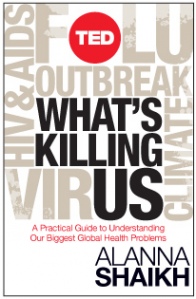This post was originally published in “Download the Universe,” a multi-author blog about science ebooks edited by Carl Zimmer.
What’s Killing Us: A Practical Guide to Understanding Our Biggest Global Health Problems. By Alanna Shaikh. Published by TED Books, 2012.
Reviewed by Tom Levenson
August 23, 2012

The last decade of the seventeenth century was a great age for London’s media junkies. Paper had become cheap enough to permit the emergence of the first real newspapers in the English-speaking world. The censors saw their reign end in 1696, the year after Parliament declined to renew the Licensing Act. With that, printers no longer had to fear harsh penalties for operating an unapproved press. Free lance journalism was emerging as a plausible way to make a sort of a living – even if one of its most prominent practitioners, Daniel Dafoe, did do his stint in debtor’s prison.
Given all that, it’s no surprise that a torrent of what we may call new media poured forth. If you had something to say and even quite modest means, you could say it – and plenty did. Readers could lay their hands on learned disputes on the question of singing in church; coiners advising the government on the best methods to prevent counterfeiting; at least one poem by a law student on the subject of long vacations.
All of these appeared in the form that truly came into its own in the 17th century. That would be the pamphlet: a modest tract, easier to write, cheaper to print, swifter to plow through than any scholar’s tome…
…All of which is to say that there is nothing new under the sun.
Flash forward roughly three hundred years, and lay your digital mitts on the subject of this review, Alanna Shaikh’s What’s Killing Us. It is an e-bite of an argument, less than forty pages to cover Shaikh’s top-ten list of global health problems. It is a pamphlet by any other name, and hence an example of one of my favorite everything-old-is-new-again gifts of the digital revolution.
One note before getting to the meat of Shaik’s work. Sharp-eyed readers will see that I’ve left unmentioned one property of What’s Killing Us. It’s a TED book, and TEDity has come in for its lumps here. This one doesn’t, or shouldn’t, in part because it does not attempt to reduce the difficult reality of global health to a trademarked Big Idea. Instead, it is an example of what TED promises but does not always deliver – a guide to thinking about a the complexity of an issue that enables – really demands that — the reader join in figuring out what the hell to do.
To grab that reader, Shaikh begins in the grand tradition of the pamphleteer, sounding the call to action: “The biggest global health problems, like tuberculosis, are getting worse.…This is the moment to get on the right road. If we don’t, the results will be ugly.” Her challenge is to convey that urgency with enough detail to persuade her readers about the various huge problems she invokes – all in the very short form she has chosen to make her case. To do so, she writes to a formula – three or four pages on each major issue, passages further broken down into sub-sections – “the basics;” “why we should worry;” and “what we can do.”
The result is a predictable read – but it works. Some of the issues tackled are well enough known as not to need much background, and Shaikh skillfully uses that familiarity to build themes that accumulate across her catalogue of woe. She begins by looking at the threat from pandemic influenza – and she uses that (for now) somewhat lower-key danger to introduce a thread running through the full range of developing-world public health crises, the need to strengthen weak health-care systems to handle local eruptions of illness.
From the flu, Shaikh moves to some of what may be called the classics of global health: diseases often associated with poverty (think obesity, pollution-exacerbated lung conditions, diabetes) and the infectious diseases of the tropics that have been historically ignored by industrial medicine and biomedical research. As she progresses, Shaikh continues to add to her catalogue of reasons to care about suffering distant strangers.
She begins with the pragmatics: diseases of poverty are (much of) what makes being poor so wretched – and wretchedness leads both to cycles of impoverishment and to increased risk of conflict. At the same time, the pragmatic argument — healthy first-worlders should care about sick people far away because bad stuff, like war and/or infectious diseases can leap borders – leads to the first hint of the moral one: the existence of preventable or treatable harm imposes an obligation on those with the means to act.
That self-interest/altruism duet swells in her account of neglected tropical diseases – thirteen to seventeen (depending on who’s counting) parasitic and bacterial diseases mostly concentrated in Sub-Saharan Africa and Asia. She cites an advocacy group’s estimate that puts the cost of an integrated control approach at as little as fifty cents per year per receipient — $700,000,000 to reach the 1.4 billion most at risk.
To digress just a bit: if that number is about right, and if Sheldon Adelson and the Koch brothers shifted their priorities just a bit, then for the same order of their contributions to GOP causes this year, they could change the lives of one fifth of all humans on earth, hundreds of millions of them kids. A man can dream…
Put another way: an endowment of about $18 billion, just over half of that possessed by Harvard University, would yield enough income to fund treatment on that scale in perpetuity. As Shaikh emphasizes in other ways, we face huge but not intractable problems.
That digression is actually an example of what Shaikh’s trying to do with (or to) her audience: she gives just enough of the story to lead readers to pick up the line of argument themselves. Some of her attempts to do so don’t work quite as well as others. Her section on HIV/AIDS offers little more than the triumph of hope over experience in a vague call for better health care systems in the developing world to deal with the specific demands of HIV prevention and care. Well, yes…but I know folks working on the front lines of such systems who surely understand that, and wouldn’t mind a little more concrete help, thank you very much.
In the latter half of her book, Shaikh expands her ambition, if that were possible, asking us to focus on the health implications of global social, cultural and environmental problems. Childhood, motherhood, urbanization, climate change are all implicated in unnecessary deaths. Women and children both prosper when women gain power over their lives, controlling over their fertility, economic autonomy and so on. Climate change, which Shaikh describes as “the single greatest threat to human health” requires addressing just about everything that humans do on earth.
If we’ve bought into the dual moral/self-interest argument by this point, we’re now asked to confront some huge – and increasingly vaguely defined – possible issues. What’s Killing Us is persuasive in making the case that these large social and environmental concerns are powerfully understood as health issues, but it doesn’t fully take the next step: what does thinking about climate change in terms of disease and poverty compel us to do, beyond vague impulses?
That is: by the end of the text, Shaikh doesn’t quite deliver on the promise of her subtitle – she’s certainly guided us through lots of stuff, but the practical bit isn’t all there. To be fair, Shaikh set out not to solve all the problems of the world, but to suggest that many of them are solvable. Even so, her closing manifesto lands with a thud: “We just need to act on [the knowledge of the issue]. We need to donate money and push our governments to donate too. We need to support scientific research, good governance, better infrastructure and clean water.”
Well, yes. Sure. We do. But that is a rather deflating list. If Shaikh had allowed herself just one more essay – not that one page epilogue but something a bit more substantial – that addressed directly what she thinks the individuals reading her work could do, she would have left folks – me – energized, charged up. Now, I’m just thinking, “Oh well. Guess I’ll to write another check.” That’s not nothing – but it’s not enough, and less than Shaikh could have achieved. This work is well worth a look; I do recommend it. But – and here I’m sure Shaikh would both agree and be pleased at the result – if it moves you at all, you’ll have to read much more.

Tom Levenson writes books (most recently Newton and the Counterfeiter) and makes films, about science, its history, and whatever else catches his magpie’s love of shiny bits. His work has been honored by a Peabody, a National Academies Science Communication and an AAAS Science Journalism Award, among others. On leave from professing science writing within MIT’s Graduate Program in Science Writing, he’s working on a book the birth of money in the age of the Scientific Revolution.